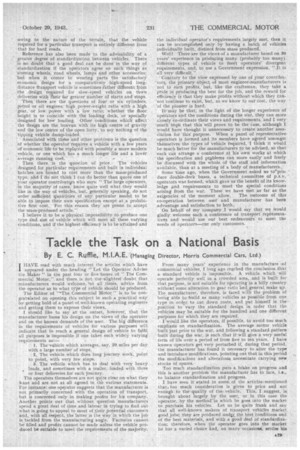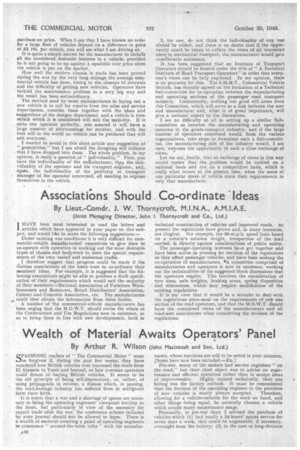Tackle the Task on a National Basis
Page 31

Page 32

If you've noticed an error in this article please click here to report it so we can fix it.
By E. C. Ruffle, M.I.A.E. (Managing Director, Morris Commercial Cars, Ltd.) I HAVE read with much interest the articles which have • appeared under the heading "Let the Operator Advise the Maker " in the past four or five issues of " The Commercial Motor," and there is flot the slightest doubt that manufacturers would welcome, ',at all times, advice from • the operator as to what tYpe of vehicle should be produced.
The Editor of "'The Commercial Motor" is to be con,gratalated on opening this subject in such .a practical way by getting hold of a panel ofwell-known operating engineers and getting them to express their views.
I, should like to say at the outset, however, that -the manufacturer bases his design on the views of the operator and on the known demands of the user. The big difference in the requirements of vehicles for various purposes will indicate that to reach a general design of vehicle to hal all purposes is impossible if one takes such widely varying requirements as:— 1. The weincle which averages, say, 20 miles per day with a large number of stops.
2._ The vehicle which does long journey work, point to point, with very few stops.
3. The vehicle which has to deal with very heavY loads, and sometimes with a trailer, loaded with three or four deliveries for each journey. •• The operators themselves are not quite clear on what they Want and are not at all agreed in the various statements. For instance: one operator suggests that the manufacturer is not primarily concerned with the operation of transport, but is concerned only in. making profits for his company. Another points out that . without question 'manufacturers ' spend a great deal of time and labour in trying to find out what is going to appeal to most of their potential customers and, with all respect, the latter is the way in which the job is tackled from the manufacturing angle. Factories cannot be filled and profits cannot -be made unless the vehicle produced be suitable to meet the requirements of the majority.
From many years' experience in the manufacture of commercial vehicles, I long ago reached the. conclusion that a standard vehicle is impossible. A vehicle which 'will operae perfectly well in a crowded area, and is built for that purpose, is not suitable for operating in a hilly country .withont some alteration to gear ratio ancLgeneral, make up. The manufacturer, therefore, is faced with the problem of being able to build as many vehicles as possible from one type in order to cut down costs, and put himself' in the position to vary the standard design in order that the vehicles may be suitable for the hundred and one different purposes for which. they are required. I would like the operators, if possible, to avoid too much emphasis on. standardization. The average motor vehicle built just prior to the war, and following a standard pattern built during the war, is such that it will give a very useful tenth of life over a period of from five to ten years. I have known operators get very perturbed if, during that period, the manufacturer has found it necessary to alter the type and introduce modifications, pointing out that in this period the modifications and alterations necessitate carrying new stocks of spares.'
Too much standardization puts a brake on progress and this is another problem the manufacturer has to face, i.e., .to balance standardization amid progress.
. I have seen it stated in some.,of the articles, mentioned that. too much cousideration is given to price and not enough to the' quality of thevehicle. This, I suggest, is brought about largely by the user, or, in this case the operator, by the method-in which he goes into the market -to purchase his vehicles. Let us be quite frank and say that all well-known makers of transport vehicles market good jobs; they are produced under the best conditions and of the best materials, and with a good deal of standardization: therefore, when the operator goes into the market he has a varied choice b.nd, on many 'occasions, settles his purchase on price. When I say that I have known an order for a large fleet of vehicles depend on a difference in price of £2 10s, per vehicle, you will see what.I am driving at.
It is quite a simple matter for the manufacturer to include all the considered desirable features in a vehicle, provided he is not going to be up against a squabble over price when the vehicle is put on the market.
Hove well the modern chassis is made has been proved during the war by the very long mileage the average commercial vehicle has done, owing to the absence 'of renewals and the difficulty of getting new vehicles. Operators have tackled. the maintenance problem in a very big way and the result has been extraordinary.
. The method used by 'most manufacturers in laying out a new vehicle is to call for reports from the sales and service departments,. consider these together with the ideas and suggestions of the designs department, aud a vehicle is then struck which it is considered will suit the majority. If it suits one operator perfectly, rest assured it will have a large number of shortcomings for another, and with the best will in the world no vehicle can be produced that will suit everyone.
I wanted to avoid in this short article any suggestion of generalities," but I am afraid the foregoing will indicate that I have dropped into them. The whole problem, in my opinion is really a question of " individuality." First, you have the individuality of the malmfacturer; then the individitaIity of the operator and his transport engineer, and; .agaion, the individuality of the .publicity or transport manager of the operator concerned, all wanting to express themselves in the vehicle.
for one, do not think the individuality of any one should be stifled, and there is no doubt that if the opportunity could be taken to collate the views of all interested users in mechanical transport, the manufacturer would gain considerable assistance.
It has been suggested that an Institute of Transport Operators should be formed under the title of ".A Technical Institute of Road Transport Operators'' in order that everyone's views can he fully expressed. In my opinion, there is no necessity for this. The S.M.11.T., Commercial Vehicle Section, has recently agreed on the formation of a Technical Sub-committee for co-operation between the manufacturing and operating sections of the passenger road, transport industry. Undoubtedly, nothing but good will come from this Committee, which will serve ds a link betweenthe user and manufacturer and, what is of great importance, will give a national aspect to the discussions.
I see no difficulty at all in setting up a similar Subcommittee as between the manufacturing and operating interests in the goods-transport industry, and if the large number of operators concerned would, from the various organizations, take stepa to formulate such a Sub-committee, the manufacturing side of .the industry would, I am sure, welcome the opportunity of such a close exchange of views. '
Let me say, finally, that an exchange of views in this Way would ensure that the . problem would be tackled on a national basis and not .on a competitive basis, which is really what occurs at the present time, when the users of one particular mak'e of vehicle state their requirements to only that manufacturer,




















































